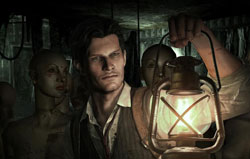The video game community has been clamoring for a return to good old-fashioned survival horror, and they were promised just that when “Resident Evil” creator Shinji Mikami was announced as the game director for “The Evil Within,” developed by Tango Gameworks and published by Bethesda Softworks. This highly anticipated title was promoted with phrases like “ammo scarcity” and “nightmare inducing,” with the trailers showing the protagonist, Sebastian Castellanos, sneaking through dark, trap-laden corridors stalked by hulking monstrosities. Above all, the world was promised that this would not be a “Resident Evil” game.
However, Mikami seems to have spent a little too much time on that franchise, because “The Evil Within” is chock-full of the same old badness that “Resident Evil” fans are used to. In fact, if you played “Resident Evil 4,” you came pretty close to playing this game. The player must dodge trip wires and bear traps while avoiding human beings that have been mutated by some powerful, previously untapped source that only the antagonist—in this case, a scientist named Ruvik—can control. Some similar enemies make a comeback too, including a giant chainsaw-wielding monster that decapitates Castellanos exactly like the Ganado did in “RE4.”
Some of these moments are obvious nods to the aforementioned franchise. For instance, the first enemy you come across is hunkered down over a corpse, eating some random organs, and looks back at the player while lightning flashes. This little Easter Egg will be familiar to those who played the original “Resident Evil.” It can be difficult to tell where homage ends and replication begins, but there are many similarities, only a few of which I’ll go into.
Overall, this was a well-done game. The graphics are fairly nice, offering an impressive range of detailing, but this is limited to the characters. While the player can count the hairs of Castellanos’s five o’clock shadow, flowers and shadows appear bulky, even pixilated, at times. The sound effects are more effective, offering an array of clangs, groans, and scuttles that left me swiveling the camera around, desperately trying to figure out if what I was hearing was a broken pipe or the hiss of something that might force me to empty my already low amount of ammo.
This can be a problem, because the camera hovers so close to the character that he takes up nearly half the screen, resulting in a lot of confusion, spinning, and sometimes, eye strain, motion sensitivity, and seizures.
The other interesting part was the difficulty. This game will kill you in dozens of ways, ranging from the mundane, such as a mutant stabbing you to death, to the occasionally hysterical, like if a bomb you’re trying to disarm detonates and sends your arms to the other end of the level.
Along with this are the fun enemies. While the Haunted are no different from “Resident Evil’s” Ganado, “The Evil Within” boasts a few unique creatures: The Sadist, The Keeper, and Laura, aka ReBone Laura, each with their own ways of killing Castellanos. While the Sadist is just the chainsaw wielding jerk from earlier, Laura has an interesting tendency to tear her way out of the many corpses that lie around on the ground and chase Castellanos, using her four arms to speed her attack. If she sprints toward him and you don’t get him out of the way, she’ll pin him down and make a blood pancake out of your head.
I should mention that this is a very bloody, graphically violent game. The aforementioned death isn’t even close to the worst you might see.
Along with the high death count is the high loading screen time. At an average of twenty seconds per loading screen, and considering the thirty deaths in my play through (the game is kind enough to tell you how many times you died), I spent ten full minutes staring at loading screens. As a rule of thumb, games that kill you a lot shouldn’t take so long to load.
The biggest fault of this game is the poor character construction and cheap dialogue. Castellanos is a walking embodiment of every rugged cop cliché, as he’s an alcoholic whose daughter was killed because of his job and his wife disappeared because she got too close to “the truth.” Later, he nearly shoots the only character who could possibly help him and gets in the way when that same character almost stops the main villain. In fact, the entire last level takes place because he’s too stubborn to admit he doesn’t know what’s going on, resulting in Ruvik obtaining insane amounts of power.
In addition to this aggravation, he has a tendency to say “What’s going on?” “Where is this place?” and “Am I losing my mind?” every time anything happens. While this would make sense at the beginning, by the end of the game (at a roughly twelve hour play-through), I got seriously tired of hearing him repeat himself.
His supporting cast is pretty much limited to Detective Joseph Oda, who likes to whine and has terrible aim, and Julie Kidman, who is “Resident Evil’s” stereotypical mysterious hot female that is secretly a double agent, a la Ada Wong. There is no explanation as to why she wears tight jeans and high heels while the men wear suits, or why she is constantly used as bait, but she is redeemed a bit by having Jennifer Carpenter, of “Dexter” fame, as her voice actress.
Kidman will be a playable character in the DLC, which has yet to be released, but I look forward to learning a little more about the only interesting character in the game. Even Ruvik, the antagonist, is an utterly two-dimensional figure: a spoiled rich boy who was burned in a fire as a child and is angry at the world because his sister perished in that same fire. He decides to take out his grief by slaughtering dozens, if not hundreds, of strangers.
I won’t spoil the ending, but I will say that it mirrors every final “Resident Evil” battle by having you fight some giant, impossible monster through a series of quick time events and a rail shooter sequence. After a cut scene, you’re given a rocket launcher and you blow it up, which is how almost every “RE” game ends.
After you beat it (on casual mode), you’re given a rocket launcher and machine gun for your next play through, but you can’t change the difficulty for new game plus mode. This means that all you gamers who like to play the easy mode and take your upgrades to harder difficulties (like I do) will be in for a rough time.
All in all, “The Evil Within” was a fun game, but I don’t think it’s an accident that ‘Evil’ wound up in the name. There are many “Resident Evil” moments in this game that had me questioning whether playing this was worth sixty dollars, but the graphics, enemies, and level design all kept me on my toes. My advice: wait until the price breaks and the DLC comes out. If the extra content gets good reviews, take a look and see if you might want to get your head smashed in one to two hundred times (on ‘normal’ difficulty). I may sound harsh, but this was a good game. If it had cost less money or been more original, it would’ve been great.
IMAGE TAKEN from flickeringmyth.com




